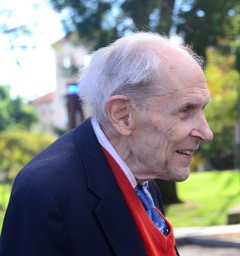The American Institute of Mathematics is pleased to announce the second annual Alexanderson Award. The award is given in honor of Gerald Alexanderson, Professor of Mathematics at Santa Clara University and founding chair of AIM’s Board of Trustees. The Alexanderson Award recognizes outstanding research articles arising from AIM research activities that have been published within the past three years.
Receiving this year’s award are Paul Bruillard, Siu-Hung Ng, Eric C. Rowell, and Zhenghan Wang for their paper “Rank-finiteness for modular categories” published in the Journal of the American Mathematics Society in 2016. The award was presented at the Alexanderson Award Ceremony and Lecture on the evening of October 4, 2019, in the Recital Hall of Santa Clara University. The lecture was given by Jordan Ellenberg, engaging author of the book How Not to Be Wrong.
Understanding and organizing the basic building blocks of mathematics and physics is one of the most natural of scientific endeavors. We do this with the elements in our periodic table, with descriptions of elementary particles, such as quarks, photons, etc. and we do this with many mathematical structures. Perhaps the simplest is the fact that every integer is a product of primes.
The authors of the 2019 Alexanderson Award paper studied the properties of mathematical structures called modular tensor categories (MTCs). These structures are models for something called topological phases of matter which occur at near zero temperatures. The authors developed a way of indexing the MTCs by a non-negative integer called the rank, and within each rank proved that there were only a finite number of such objects.
To see how one might prove such a result (but not the actual proof of their result), here is a simple version of the technique. If one considers the equation \(a^2 + b^2 = c^2\) and asks for all relatively prime integer solutions, there are infinitely many triples, called Pythagorean triples. But if one requires that \(a, b\), and \(c\) only have prime factors from a finite set of primes, then there are only finitely many solutions. This is not obvious, and it is rather difficult to prove. Something similar was carried out in the winning paper by making use of concepts analogous to the prime numbers and integers.
The results in the paper are a wonderful example of the interplay of mathematics and physics and understanding the physical world through the elegance of mathematics. A more complete description by the authors is available here.
Read the online version of the paper here.
Gerald Alexanderson

A member of the Santa Clara faculty since 1958, Jerry has served his institution and the broader mathematics community in various capacities. During this time, he was chair of the Mathematics department for 35 years and a member of the Faculty Senate Council. For thirty eight years he held the endowed Valeriote Professorship of Science chair. Known as an inspiring teacher and popular author, Alexanderson has cultivated a passion for problem solving and has promoted creative mathematical thinking as longstanding Associate Director of the prestigious William Lowell Putnam Competition. He is author of more than a dozen books, including textbooks in abstract algebra, and discrete and combinatorial mathematics. Alexanderson was the first recipient of Santa Clara University’s Bayma Award for Scholarship, and he received the Special Appreciation Award from the Dean of Arts and Sciences as well as the Special Recognition Award for Teaching, Research, and Service from the President of the university.
Alexanderson’s influence has extended to the national level, where he has played a leading and lasting role in the Mathematical Association of America (MAA). His contributions to the MAA have spanned more than 50 committees and 24 years on the Board of Governors, encompassing secretary, vice-president, and president of the Association and editor of Mathematics Magazine. Results of this work include the remodeling of the MAA Carriage House in Washington, D.C., into its Mathematical Sciences Conference Center. In this time, Jerry served on the Science Policy Committee of the American Mathematical Society (AMS) and was a consultant to the Editorial Board for the Bulletin of the AMS. In testament to his expansive record, Alexanderson received the MAA’s most prestigious award for distinguished service to Mathematics, the Yueh-Gin Gung and Dr. Charles Y. Hu award.


